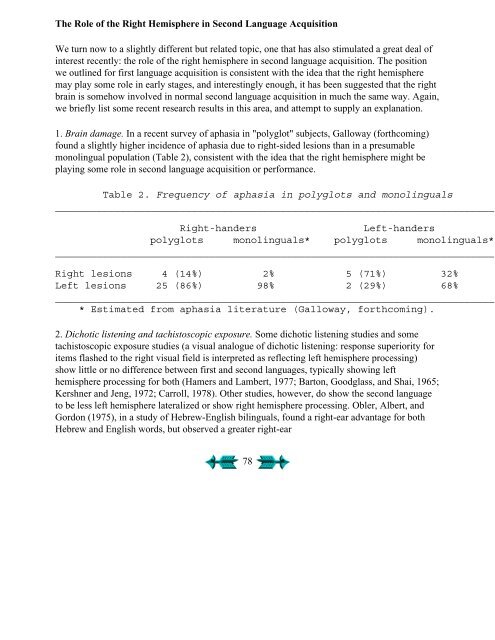Second Language Acquisition and Second ... - Stephen Krashen
Second Language Acquisition and Second ... - Stephen Krashen
Second Language Acquisition and Second ... - Stephen Krashen
You also want an ePaper? Increase the reach of your titles
YUMPU automatically turns print PDFs into web optimized ePapers that Google loves.
The Role of the Right Hemisphere in <strong>Second</strong> <strong>Language</strong> <strong>Acquisition</strong><br />
We turn now to a slightly different but related topic, one that has also stimulated a great deal of<br />
interest recently: the role of the right hemisphere in second language acquisition. The position<br />
we outlined for first language acquisition is consistent with the idea that the right hemisphere<br />
may play some role in early stages, <strong>and</strong> interestingly enough, it has been suggested that the right<br />
brain is somehow involved in normal second language acquisition in much the same way. Again,<br />
we briefly list some recent research results in this area, <strong>and</strong> attempt to supply an explanation.<br />
1. Brain damage. In a recent survey of aphasia in "polyglot" subjects, Galloway (forthcoming)<br />
found a slightly higher incidence of aphasia due to right-sided lesions than in a presumable<br />
monolingual population (Table 2), consistent with the idea that the right hemisphere might be<br />
playing some role in second language acquisition or performance.<br />
Table 2. Frequency of aphasia in polyglots <strong>and</strong> monolinguals<br />
__________________________________________________________________________<br />
Right-h<strong>and</strong>ers Left-h<strong>and</strong>ers<br />
polyglots monolinguals* polyglots monolinguals*<br />
__________________________________________________________________________<br />
Right lesions 4 (14%) 2% 5 (71%) 32%<br />
Left lesions 25 (86%) 98% 2 (29%) 68%<br />
__________________________________________________________________________<br />
* Estimated from aphasia literature (Galloway, forthcoming).<br />
2. Dichotic listening <strong>and</strong> tachistoscopic exposure. Some dichotic listening studies <strong>and</strong> some<br />
tachistoscopic exposure studies (a visual analogue of dichotic listening: response superiority for<br />
items flashed to the right visual field is interpreted as reflecting left hemisphere processing)<br />
show little or no difference between first <strong>and</strong> second languages, typically showing left<br />
hemisphere processing for both (Hamers <strong>and</strong> Lambert, 1977; Barton, Goodglass, <strong>and</strong> Shai, 1965;<br />
Kershner <strong>and</strong> Jeng, 1972; Carroll, 1978). Other studies, however, do show the second language<br />
to be less left hemisphere lateralized or show right hemisphere processing. Obler, Albert, <strong>and</strong><br />
Gordon (1975), in a study of Hebrew-English bilinguals, found a right-ear advantage for both<br />
Hebrew <strong>and</strong> English words, but observed a greater right-ear<br />
78











